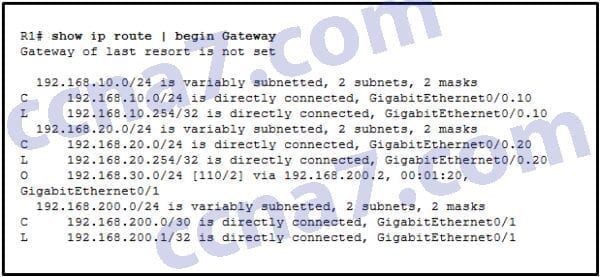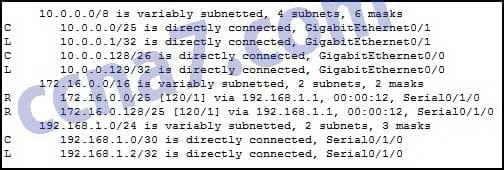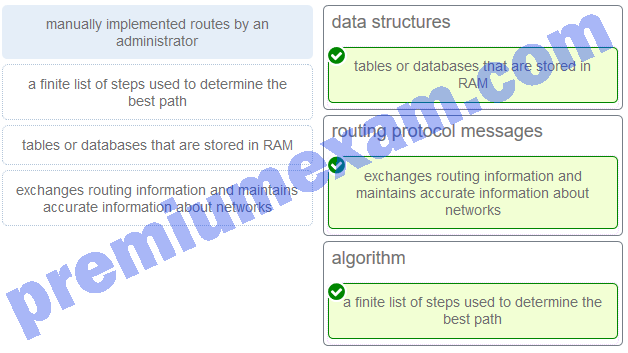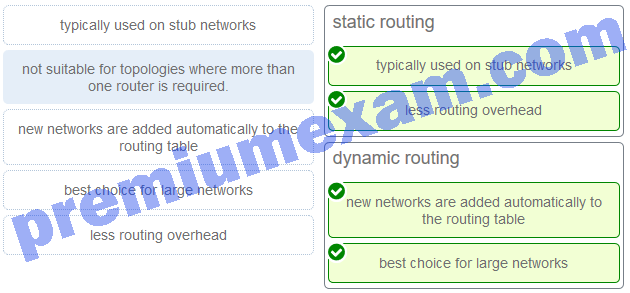Last Updated on January 28, 2021 by Admin
CCNA2 v6.0 Chapter 3 Exam Answers 2018 2019
From year to year, Cisco has updated many versions with difference questions. The latest version is version 6.0 in 2018. What is your version? It depends on your instructor creating your class. We recommend you to go thought all version if you are not clear. While you take online test with netacad.com, You may get random questions from all version. Each version have 1 to 10 different questions or more. After you review all questions, You should practice with our online test system by go to "Online Test" link below.
| Version 5.02 | Version 5.03 | Version 6.0 | Online Assessment |
| Chapter 3 Exam | Chapter 3 Exam | Chapter 3 Exam | Online Test |
| Next Chapter | |||
| Chapter 4 Exam | Chapter 4 Exam | Chapter 4 Exam | Online Test |
| Lab Activities | |||
| 3.2.1.8 Packet Tracer – Configuring RIPv2 | |||
-
Which dynamic routing protocol was developed to interconnect different Internet service providers?
- BGP
- EIGRP
- OSPF
- RIP
Explanation: BGP is a protocol developed to interconnect different levels of ISPs as well as ISPs and some of their larger private clients.
-
Which routing protocol is limited to smaller network implementations because it does not accommodate growth for larger networks?
- OSPF
- RIP
- EIGRP
- IS-IS
Explanation: The RIP protocol was created with a metric that does not support larger networks. Other routing protocols, including OSPF, EIGRP, and IS-IS, scale well and accommodate growth and larger networks.
-
What two tasks do dynamic routing protocols perform? (Choose two.)
- discover hosts
- update and maintain routing tables
- propagate host default gateways
- network discovery
- assign IP addressing
-
When would it be more beneficial to use a dynamic routing protocol instead of static routing?
- in an organization with a smaller network that is not expected to grow in size
- on a stub network that has a single exit point
- in an organization where routers suffer from performance issues
- on a network where there is a lot of topology changes
Explanation: Dynamic routing protocols consume more router resources, are suitable for larger networks, and are more useful on networks that are growing and changing.
-
When would it be more beneficial to use static routing instead of dynamic routing protocols?
- on a network where dynamic updates would pose a security risk
- on a network that is expected to continually grow in size
- on a network that has a large amount of redundant paths
- on a network that commonly experiences link failures
Explanation: Dynamic routing protocols are viewed as less secure than static routing because they commonly forward routing information on the same links that data traffic is crossing.
-
What is a purpose of the network command when configuring RIPv2 as the routing protocol?
- It identifies the interfaces that belong to a specified network.
- It specifies the remote network that can now be reached.
- It immediately advertises the specified network to neighbor routers with a classful mask.
- It populates the routing table with the network entry.
Explanation: The network command is used to advertise the directly connected networks of a router. It enables RIP on the interfaces that belong to the specified network.
-
A network administrator configures a static route on the edge router of a network to assign a gateway of last resort. How would a network administrator configure the edge router to automatically share this route within RIP?
- Use the auto-summary command.
- Use the passive-interface command.
- Use the network command.
- Use the default-information originate command.
Explanation: The default-information originate command instructs a router to propagate the static default route in RIP or OSPF.
-
What is the purpose of the passive-interface command?
- allows a routing protocol to forward updates out an interface that is missing its IP address
- allows a router to send routing updates on an interface but not receive updates via that interface
- allows an interface to remain up without receiving keepalives
- allows interfaces to share IP addresses
- allows a router to receive routing updates on an interface but not send updates via that interface
-
Which route would be automatically created when a router interface is activated and configured with an IP address?
- D 10.16.0.0/24 [90/3256] via 192.168.6.9
- C 192.168.0.0/24 is directly connected, FastEthernet 0/0
- S 192.168.1.0/24 is directly connected, FastEthernet 0/1
- O 172.16.0.0/16 [110/65] via 192.168.5.1
Explanation: Directly connected networks are identified with a C and are automatically created whenever an interface is configured with an IP address and activated.
-
Refer to the exhibit. Which two types of routes could be used to describe the 192.168.200.0/30 route? (Choose two.)

CCNA2 v6.0 Chapter 3 Exam 002
- ultimate route
- level 1 parent route
- level 1 network route
- level 2 child route
- supernet route
Explanation: A level 2 child route is a route that has a network with a mask that is greater than the classful equivalent. An ultimate route is a route that uses a next-hop IP address or exit interface to forward traffic.
-
What occurs next in the router lookup process after a router identifies a destination IP address and locates a matching level 1 parent route?
- The level 2 child routes are examined.
- The level 1 supernet routes are examined.
- The level 1 ultimate routes are examined.
- The router drops the packet.
Explanation: When a router locates a parent route that matches the destination IP address of a packet, the router will then examine the level 2 child routes contained within it.
-
Which route would be used to forward a packet with a source IP address of 192.168.10.1 and a destination IP address of 10.1.1.1?
- C 192.168.10.0/30 is directly connected, GigabitEthernet0/1
- S 10.1.0.0/16 is directly connected, GigabitEthernet0/0
- O 10.1.1.0/24 [110/65] via 192.168.200.2, 00:01:20, Serial0/1/0
- S* 0.0.0.0/0 [1/0] via 172.16.1.1
Explanation: Even though OSPF has a higher administrative distance value (less trustworthy), the best match is the route in the routing table that has the most number of far left matching bits.
-
Which two requirements are used to determine if a route can be considered as an ultimate route in a router’s routing table? (Choose two.)
- contain subnets
- be a default route
- contain an exit interface
- be a classful network entry
- contain a next-hop IP address
Explanation: An ultimate route is a routing table entry that contains either a next-hop IP address (another path) or an exit interface, or both. This means that directly connected and link-local routes are ultimate routes. A default route is a level 1 ultimate route, but not all ultimate routes are default routes. Routing table entries that are subnetted are level 1 parent routes but do not meet either of the two requirements to be ultimate routes. Ultimate routes do not have to be classful network entries.
-
What is a disadvantage of using dynamic routing protocols?
- They are only suitable for simple topologies.
- Their configuration complexity increases as the size of the network grows.
- They send messages about network status insecurely across networks by default.
- They require administrator intervention when the pathway of traffic changes.
Explanation: By default, dynamic routing protocols forward messages across a network without authenticating the receiver or originator of traffic. Static routes increase in configuration complexity as the network grows larger and are more suitable for smaller networks. Static routes also require manual intervention when a network topology changes or links become disabled.
-
Which two statements are true regarding classless routing protocols? (Choose two.)
- sends subnet mask information in routing updates
- sends complete routing table update to all neighbors
- is supported by RIP version 1
- allows for use of both 192.168.1.0/30 and 192.168.1.16/28 subnets in the same topology
- reduces the amount of address space available in an organization
-
Refer to the exhibit. Based on the partial output from the show ip route command, what two facts can be determined about the RIP routing protocol? (Choose two.)

CCNA2 v6.0 Chapter 3 Exam 003
- RIP version 2 is running on this router and its RIP neighbor.
- The metric to the network 172.16.0.0 is 120.
- RIP version 1 is running on this router and its RIP neighbor.
- The command no auto-summary has been used on the RIP neighbor router.
- RIP will advertise two networks to its neighbor.
Explanation: The router learned, via RIP, that 172.16.0.0 is variably subnetted, and that there are two subnet and mask entries for that network. This means that RIP version 2 is running on both routers and that the command no auto-summary has been applied on the neighbor router. RIPv2 has an administrative distance of 120 and this router will advertise all connected networks to the neighbor via 192.168.1.1.
-
While configuring RIPv2 on an enterprise network, an engineer enters the command network 192.168.10.0 into router configuration mode.
What is the result of entering this command?
- The interface of the 192.168.10.0 network is sending version 1 and version 2 updates.
- The interface of the 192.168.10.0 network is receiving version 1 and version 2 updates.
- The interface of the 192.168.10.0 network is sending only version 2 updates.
- The interface of the 192.168.10.0 network is sending RIP hello messages.
Explanation: The command being entered by the engineer will cause RIPv2 to activate on the interface for the 192.168.10.0 network. If RIPv1 is configured, the router will send only version 1 updates, but will listen for both version 1 and version 2 updates. If RIPv2 is configured, the router will send and listen to only version 2 updates.
-
A destination route in the routing table is indicated with a code D. Which kind of route entry is this?
- a static route
- a route used as the default gateway
- a network directly connected to a router interface
- a route dynamically learned through the EIGRP routing protocol
Explanation: Routes in a routing table are manually created or dynamically learned. Letter D indicates that the route was learned dynamically through the EIGRP routing protocol.
-
Refer to the exhibit. Which interface will be the exit interface to forward a data packet with the destination IP address 172.16.0.66?

CCNA2 v6.0 Chapter 3 Exam 001
- Serial0/0/0
- Serial0/0/1
- GigabitEthernet0/0
- GigabitEthernet0/1
Explanation: The destination IP address 172.16.0.66 belongs to the network 172.16.0.64/26. In the routing table there is a route learned by EIGRP (identified with code “D”) with 192.168.1.6 as the next-hop address and Serial 0/0/1 as the exiting interface.
-
Which type of route will require a router to perform a recursive lookup?
- an ultimate route that is using a next hop IP address on a router that is not using CEF
- a level 2 child route that is using an exit interface on a router that is not using CEF
- a level 1 network route that is using a next hop IP address on a router that is using CEF
- a parent route on a router that is using CEF
Explanation: When Cisco Express Forwarding (CEF) is not being used on a router, a recursive lookup must be performed when a route using a next-hop IP address is selected as the best pathway to forward data.
-
Which route is the best match for a packet entering a router with a destination address of 10.16.0.2?
- S 10.0.0.0/8 [1/0] via 192.168.0.2
- S 10.16.0.0/24 [1/0] via 192.168.0.9
- S 10.16.0.0/16 is directly connected, Ethernet 0/1
- S 10.0.0.0/16 is directly connected, Ethernet 0/0
-
A router is configured to participate in multiple routing protocol: RIP, EIGRP, and OSPF. The router must send a packet to network 192.168.14.0. Which route will be used to forward the traffic?
- a 192.168.14.0/26 route that is learned via RIP
- a 192.168.14.0/24 route that is learned via EIGRP
- a 192.168.14.0/25 route that is learned via OSPF
- a 192.168.14.0/25 route that is learned via RIP
Explanation: Before the administrative distance of a route is compared, the route with the most specific best match is utilized. The 192.168.14.0/26 network contains the best match to the destination IP address of 192.168.14.20 and thus the 192.168.14.0/26 RIP route is utilized over the EIGRP and OSFP routes, regardless of administrative distance.
-
What is different between IPv6 routing table entries compared to IPv4 routing table entries?
- IPv6 routing tables include local route entries which IPv4 routing tables do not.
- By design IPv6 is classless so all routes are effectively level 1 ultimate routes.
- The selection of IPv6 routes is based on the shortest matching prefix, unlike IPv4 route selection which is based on the longest matching prefix.
- IPv6 does not use static routes to populate the routing table as used in IPv4.
Explanation: Routers running IOS release 15 have link local routing table entries for both IPv4 and IPv6. The selection of both IPv6 routes and IPv4 routes is based on the longest matching prefix. The routing tables of both IPv6 and IPv4 use directly connected interfaces, static routes, and dynamically learned routes.
-
Match the dynamic routing protocol component to the characteristic. (Not all options are used.)

Explanation: The three components of dynamic routing protocols include:
- Data structures
- Routing protocol messages
- Algorithm
-
Match the characteristic to the corresponding type of routing. (Not all options are used.)

Explanation: Both static and dynamic routing could be used when more than one router is involved. Dynamic routing is when a routing protocol is used. Static routing is when every remote route is entered manually by an administrator into every router in the network topology.
From year to year, Cisco has updated many versions with difference questions. The latest version is version 6.0 in 2018. What is your version? It depends on your instructor creating your class. We recommend you to go thought all version if you are not clear. While you take online test with netacad.com, You may get random questions from all version. Each version have 1 to 10 different questions or more. After you review all questions, You should practice with our online test system by go to "Online Test" link below.
| Version 5.02 | Version 5.03 | Version 6.0 | Online Assessment |
| Chapter 3 Exam | Chapter 3 Exam | Chapter 3 Exam | Online Test |
| Next Chapter | |||
| Chapter 4 Exam | Chapter 4 Exam | Chapter 4 Exam | Online Test |
| Lab Activities | |||
| 3.2.1.8 Packet Tracer – Configuring RIPv2 | |||